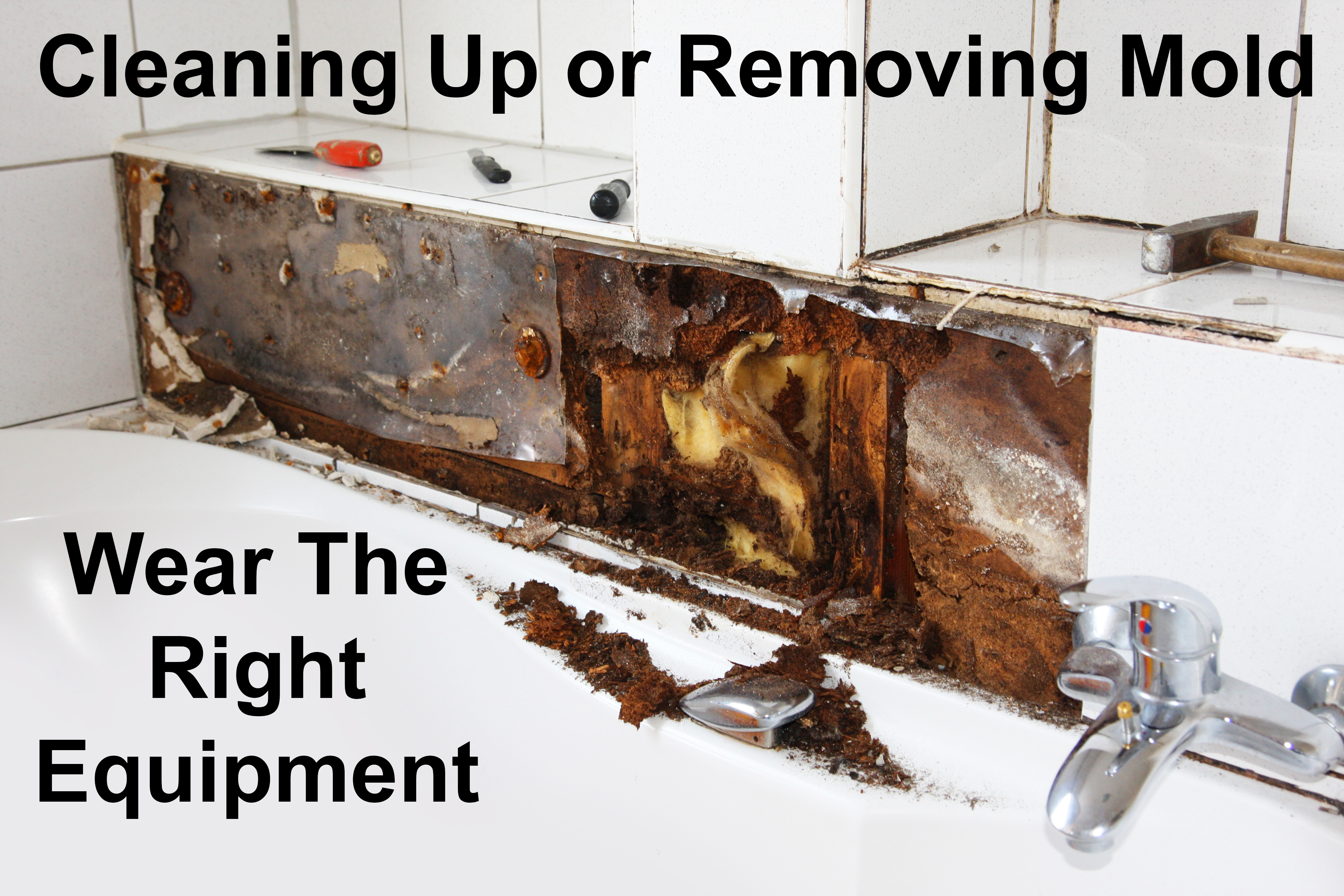what type of mask to use for mold
Knowing what to clothing when removing mold in your abode will practice a lot to protect you from unhealthy and toxic mold spores and the toll is really non that much.
Removing mold, whether cleaning or tearing out drywall, insulation, carpet, etc. can be hazardous to your health. It's critical to wear the right clothing and equipment to prevent animate of mold spores or getting them on your skin. The EPA (Ecology Protection Bureau) has a fix of recommended guidelines that are basically broken down into iii levels.
- Minimum PPE requirement level (under 10 foursquare feet)
- Limited PPE requirement level (10 to 100 square feet)
- Total PPE requirement level (100 or more than square feet)
The letters "PPE" refers to Personal Protective Equipment
Personal Protective Equipment is fundamental in limiting your exposure to mold and mold spores, considering in one case yous start the clean-upwards and removal process, millions of microscopic mold spores become airborne. Companies that specialize in removing and eliminating mold are commonly referred to every bit "Mold Remediation" companies or contractors.
Can a homeowner do their own mold make clean-upwards / remediation?
In nearly instances you tin, however, if you live in a condo or apartment where there is a risk that yous may contaminate your neighbor'south unit there may be some form of governmental regulations, guidelines or permits required. A quick call to your local edifice department will normally answer whatever questions yous have about governmental requirements.
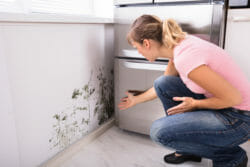
Stachybotrys, Cladosporium, Penicillium, Aspergillus, and Alternaria.
Mold spores grow in many types of building materials, including drywall, wood, insulation, carpet and fifty-fifty grit. Having the proper protection will assist protect you from mold spores whether y'all're just cleaning mold off of surfaces or trigger-happy out drywall, rotten woods or moldy insulation.
The EPA, Environmental Protection Agency, provides guidelines and recommendations for contractors, mold remediation companies, as well as, to homeowners. There are many recommendations and pages and pages of guidelines, just at that place are 3 to 5 pieces of personal protection items that homeowners or domicile buyers should accept at a minimum when working with mold, especially toxic mold.( Read almost health concerns and bug )
Deciding what equipment to get or wear frequently depends on the size of the area you lot're dealing with.
The EPA recommendations are broken downwards into three bones levels
1 – Minimum PPE requirements
- N-95 respirator (mask)
- Goggles/eye protection
- Gloves
The get-go level is suggested for small areas in a domicile that are less than 10 square feet in size. The post-obit should be considered as minimum requirements when doing remediation activities.
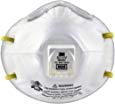
N95 Respirator
Facemask / N95 respirator is designed to accept a close facial fit covering the nose and mouth and to filter out small (down to 0.3 micron in size) airborne particles: N95 respirators will filter out near 95% of airborne particulates.
Think, that if your mask becomes damaged, soiled or y'all have a hard time animate through it, that it should be replaced with another one.

Goggles
Wearing the proper type of goggles will help preclude or reduce dust and small-scale particles from getting into your eyes. When choosing your goggles they should accept protected venting to help prevent fogging and they should not have open up vents holes with no type of filtering material covering the holes. Regular one-time safety spectacles with the small open up holes on the sides are not adequate to keep mold spores from infiltrating into the glasses, and so exist sure to get the right kind goggles.
Goggles that resist fogging, that fit well will with an adjustable ring and that have good filtered ventilation are desirable.
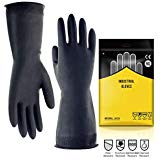
Gloves
When investigating or removing moldy materials you should protect your pare from coming into contact with mold, too as from the chemicals in cleaning solutions. Depending on the type of remediation that y'all are doing you may want to wear long gloves rather than short gloves.
If working with cleaners, such every bit chlorine bleach or strong chemicals, then the gloves are ordinarily: Neoprene, natural condom, Nitrile, Polyurethan or Polyvinylchloride (PVC). If using mild household soaps or detergents, and so regular everyday condom gloves should exist fine.
2 – Limited PPE requirements
- N-95 respirator or half-face respirator with P100 (HEPA) filter
- Goggles/eye protection
- Gloves
- Disposable overalls
When doing level 2 work, 10 to 100 square foot area, it is recommended that yous have a N-95 respirator or a one-half or full-face up respirator with a HEPA filter, plus disposable overalls besides as gloves. Retrieve that a one-half-face respirator does not protect the eyes, therefore proper goggles will be needed.
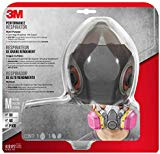
Half-confront respirators and P100 filters
The term "APRs" commonly refers to Air Purifying Respirators. When using an Apr respirator information technology should accept a P100 filter, which is often a cartridge type of filter that can be hands replaced as needed.
P100 filters will block 99.9% of particles 0.3 microns or larger and are usually considered to have the highest rating for personal respiratory protection. They're very constructive in trapping microscopic mold spores.
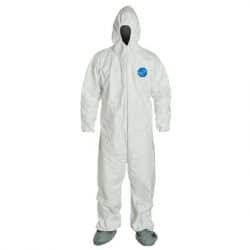
Overalls
Protection of your skin and personal clothing from mold spores and contaminated minor particles in medium size projects (10 to 100 square anxiety) and large ones (over 100 foursquare anxiety) is wise. For small type projects where just express protection is reasonable, the disposable paper coveralls is generally ok. If the project requires a more robust blazon of protection, then a sturdy breathable type of fabric is best, such as TYVEK®. Depending on the size and complication of piece of work, wearing mold-impervious disposable head and pes coverings are recommended.
Note some coveralls come with caput and foot protection fastened and other coveralls you would demand to acquire booties and head coverings separately. When suiting up in coveralls and if the ankle or sleeve areas don't accept elastic bans to prevent gaps, then some remediators will use duct tape to seal the gaps.
three – Level – Full PPE requirements
- Gloves, disposable full body clothing, head gear, foot coverings, full-face respirator with HEPA filter
On these types of projects where bigger areas are involved, boilerplate homeowners typically do not attempt to do the work themselves but have a mold remediation company do the work.
This level normally has more complex personal protection equipment and it is not unusual for professional training to be required in order to apply some of the Personal Protection Equipment. For example, if a powered air purifying respirator uses a blower to force air through the filter to a mask that covers the wearer's face or a hood that covers the entire head and it is not gear up properly or fits properly, then the wearer will be exposed to college levels of airborne dust and mold spores. When dealing with large and complex jobs its critical to take the proper equipment and training
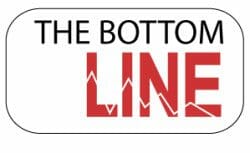
Mold is a serious concern in any home and should be removed for the wellness of the occupants and at times to prevent structural damage. If yous undertake heavy duty cleaning or removing moldy drywall, insulation, carpet or any other materials that mold is on or in, you should wear "PPE" equipment.
In some of our manufactures we provide links to products that may be beneficial given the subject matter of the content. We receive a small-scale committee if y'all choose to purchase a product or service after following one of our affiliate links but the price is the same for you.
Source: https://buyersask.com/mold/what-to-wear-when-removing-mold-in-your-home/
